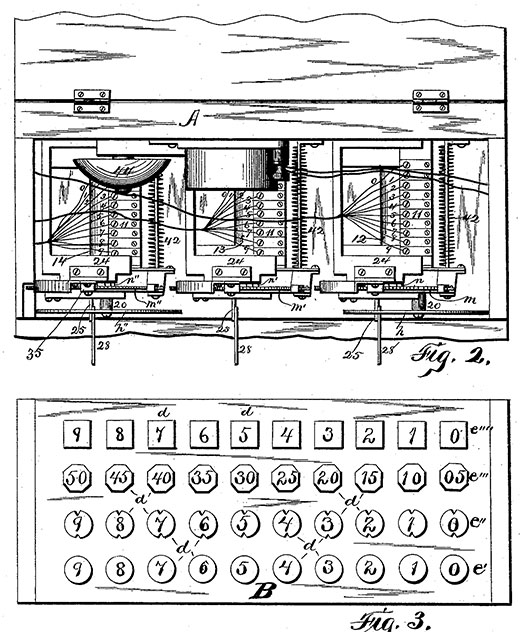Some inventors’ names are synonymous with their inventions. For example, Thomas Edison is well known for inventing the incandescent light bulb and the phonograph as well as many other innovations. And Alexander Graham Bell is famous for having invented the telephone. But most people aren’t familiar with Willard Legrand Bundy, who invented the first electric cash register and the employee time clock.

Willard Legrand Bundy
At the end of the 1880s Willard Legrand Bundy (1845-1907), an owner of a jewelry store in Auburn, New York, (see biography of Willard Legrand Bundy), devised the first electric cash register in the world. The device was patented in 1890 (US patent Nr. 443475).
Willard Bundy was a businessman and inventor, who obtained patents for many mechanical devices but was mainly known for the invention in 1888 of a mechanical time clock, an early version of the time recorder (a mechanical device that recorded when workers clocked in and out of work), which was manufactured in a company of Bundy brothers (Willard had a younger brother—Harlow E. Bundy).
Let’s examine the electric (battery-powered) cash register of Bundy, using the patent drawing (see the image below).

The object of the invention was to provide electrically actuated cash drawers or registers designed for use in stores by cashiers, combining with it the adding machine to add the amounts each and every time a button or buttons are pressed to make up the sum placed in the drawer, at the same time to indicate and display the amount of each purchase on one or more dials, one dial indicating units, another tens, a third hundreds or dollar-units, and so on.
Also to provide means by which two or more dials can be operated to indicate a large amount by actuating two or more buttons in succession; to release the drawer by the making of a circuit; to automatically throw the drawer open; to provide means to prevent the reopening of the drawer after being fully closed or to prevent its being reopened after being partly closed without the drawer is first fully closed and then reopened by the pressure upon a button; to provide a double-figure button operating to open the drawer by making a double contact successively and simultaneously operating the disk of units and the disk of tens; to provide means for registering each and every time the front of the case is opened, whereby access is obtained to the registering-dials; to ascertain the total amount taken in; to provide means by which the amount of each purchase is displayed upon the back of the apparatus to show the customer the registry when the back is toward him, and to actuate all of the several mechanisms by the electrical contact of any of the single or double buttons.
Willard Bundy (and the companies, associated with him) was also a holder of quite a few other patents in the area of cash registers and calculating machines. In 1891 he obtained a patent for card-printing attachment for cash registers (US patent 457766). He was also a holder of the following US patents: Nr. 1113099 and Nr. 1117200 for calculating machines; Nr. US617560 for Type Writing and Adding Machine. They had also patents in Austria (AT19424B and AT27631B), Germany (DE194212 and DE197451), France (FR331823 and FR360783), and Great Britain (GB190300409 and GB190516651).

Bundy Adding Machine (see image above) was advertised in 1904-1906 (see the article in The Binghamton Press from September 1904) and was put in production by Bundy Mfg. Co. of Binghamton, NY, managed by Harlow E. Bundy.
Bundy’s Time Clock Invention
Bundy is even more well known for the invention of an employee time clock in 1888. The following year, he opened a manufacturing company to mass-produce this valuable new instrument. By 1898, he had sold 9,000 Bundy Time Recorders. This became such a popular tool that his company grew and merged with others, resulting in the International Time Recorder Company (ITR) in the first decade of the 20th century.
Willard Legrand Bundy: Early Life, Career Marriage, Children, and Death
Willard Legrand Bundy was born on December 8, 1845, in Otsego, New York. Later, his family moved to Auburn, NY. From 1865 to 1885, he worked as a jeweler and clockmaker in Auburn. He and his younger brother Harlow Elisha founded the Bundy Manufacturing Recording Company in Binghamton, NY, to manufacture one of Willard’s inventions, the Workman’s Time Recorder.
Willard Legrand Bundy married Esther Decatur “Etta” Sweet in 1871. They had two sons: Willard H. and Royal D.
Bundy died of pneumonia on January 19, 1907.


